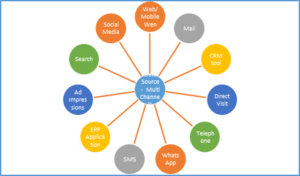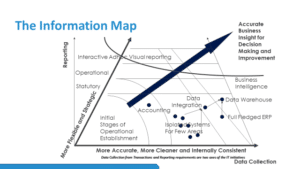“You can’t manage what you don’t measure,” W. Edwards Deming and Peter Drucker.
As Old adage says, God is in everything, and everything is God, nothing moves in the world without God. In Digital World, Data is everywhere, everything is Data, no decision without Data due to invention and advancement of technology, which includes IoT, AI etc
Digital Data – IN A RAPIDLY CHANGING global business environment, the pressure on organizations to make accurate and timely decisions has never been greater. The ability to identify challenges, spot opportunities, and adapt with agility is not just a competitive advantage but also a requirement for survival. In the above context, due to digital transformation across the world, business entities are around the digital data, captured through multi-channel for which huge investments are being made to take competitive advantages. In order to get more value from the data, companies are engaging more muscles today in the process of capturing huge amounts of internal and external data besides hiring new talents to manage and exploit these new assets.
Objective
This paper presents the main concepts related to the Digital Data, Digital Data Economy, Digital data Decision. Digital data is associated with a new generation of technologies and architectures which can harness the value of very large volumes of very varied data through real time processing and analysis. The objective of this study & research of this paper to highlights the need of data driven decision is the key to succeed in business strategy and every decision taken should be based on data value driven. We live in Data Economy, with advanced business intelligence tools, organizations are inching closer and closer to understanding the value of data-driven decision-making across all department functions and its roles. For example, the feedback taken from OLA / UBER user would enable the customer journey is to redefine the user experience. The data collected can be used for further improvements and deliver improved customer experience in the future rides.
Characteristics of Digital Data
Since COVID-19 pandemic, natural disasters and regulatory changes and political challenges, international relationship, business, public institutions, citizens facing unprecedented changes challenges – as well as opportunities. When your initiatives are backed by data, they become more predictable, leading to better planning and growth results. While a lot of businesses talk about having a data driven marketing approach, very few talk, understand and how it is done.
Data Sourcing-Multi-Channel
Recall the late 1990s and late 2000, organization dependency only on single or two channel for data collection and the organization today moved away from the rigid data sourcing model to automated data sourcing multichannel and all the need organization to have right data scientist to look deep into the data from all angles and provide valuable insight to the leadership team to make decision.
 Data Decision making models?
Data Decision making models?
Opinion based
It is very old model, but it provides fast decisions, however, the decision quality can be low which is dangerous for enterprise strategic decisions. However, it can be applied for fast
decisions making in cases where: a) High quality data is not available b) Cost of analysis is more than the value of a good decision
Driven by limited amount of data
Organizations with data quality or availability issues are likely to rely on limited amounts of data to make decisions. This is potentially the most dangerous decision making using this model as decision makers could use limited data to support their opinions, leading to widely supported but opinion based decisions. This is generally used in Government sector where bureaucrat’s makes final decision based on the limited data.
Data-driven decision making via manual analysis
This model, data needs to be available in high quality and there needs to be consensus about the correctness of data from each department / section. It is the preferable approach for important decisions where timing is not critical and where cost of automation is prohibitive compared to its benefits. To enable this, companies need to: a) manage their data efficiently and effectively b) ensure the quality of their data; c ) rely on powerful ; c ) Analytics/business intelligence tools
Automated data-driven decision making using AI & ML.
Data is available and high quality and there is consensus about the correctness of data and it has been processed so decisions are made automatically. Based on outcomes, the decision making model continuously improves itself over time. However, audit is challenging when reasons for decisions are not provided. To achieve this, companies need to apply the latest machine learning and AI approaches to build automated, operational models based on their data.
Digital Data along with Algorithm for better business decision
When humans make decisions, the process is often muddy, biased, or limited by our inability to process information overload. Data and analytics can change all that by bringing in more data points from new sources, new channels, breaking down information irregularities, and adding automated algorithms to make the process instantaneous. As the sources of data grow richer and more diverse, there are many ways to use the resulting insights to make decisions faster, more accurate, more consistent, and more transparent.
There are many examples of how this can play out in industries and domains across the economy. Smart cities, for example, are one of the most promising settings for applying the ability of machines and algorithms to process huge quantities of information in a fraction of the time it takes humans. Using sensors to improve traffic flows and the internet of things to enable utilities to reduce waste and keep infrastructure systems working at top efficiency. In the recent development of Covid-19 , advanced analytical support tools helped the health specialists, virologists to come up with better vaccines in a record-time, which in normal course takes 10 to 15 years to bring up the vaccines, thereby ensuring that the vaccines are safe and administered to all age groups as per the survey from the advanced countries.
Six Drivers of the Digital Data Age
Primary accelerants of the Data Age are emerging technologies powered by, and contributing to, exponential data growth are
- 5G networking
- The Internet of things (IoT)
- Artificial intelligence and machine learning (AI/ML)
- Augmented and virtual reality (AR/VR)
- Block Chain
- Edge computing
Key Industry verticals which drives the Digital Data Age across Globe.
Financial services is the top vertical in terms of current development of use cases. Retail comes second in most cases, though retailers lag notably in adoption of AI.
Healthcare organizations say that half or more of their data is dark, and they struggle to manage and leverage data.
The Insurance Sector lags behind commercial organizations in adoption of emerging technologies.
Manufacturing (78%) predict growth in data volume than in any other industry; 76% expect the value of data to continue to rise.
Lead Countries that Focus on Data & Data Growth:
China
Published sources says 90% of respondents from China expect the value of data to grow. They’re by far the most optimistic about the impact of emerging technologies, and they’re preparing: 83% of Chinese organizations are prepared or preparing for rapid data growth, compared to just 47% in other regions.
United States
U.S. respondents are the second most confident in their ability to prepare for rapid data growth, with 59% indicating that they are at least somewhat confident.
France
In France, 59% says that no one in their organization is having conversations about the impact of the next wave of data, but it is critical to use it.
Japan
Japan, 67% say their organization is struggling to stay up to date, compared to the global average of 58%, in terms of usage of data and its application.
United Kingdom
UK report relatively low current usage of emerging technologies but are optimistic about plans to use them in the future for better business decisions
India
In order to get more value from their data, companies are engaged today in the process of capturing huge amounts of internal and external data besides hiring new talents to manage and exploit these new assets. Yet, few organizations are able to realize the full potential of their data and analytics capabilities.
Information Age Model in India (Mid 1990)
Recall, 20 years back incidents where an employee reluctant to enter the data as it is very challenging and working on 8 hours in front of monitor is tiring work for them. In fact, those days organizations have relatively very little understanding on the data and its value due to lack of usage of the data, except the data which are required to be presented to the statutory requirements.
 Today due to advancements of technology the data are pouring through multiple channels over and above regular capturing of data through the implemented applications like CRM, HRM, ERP etc In addition to the datasets capturing has moved long way from numbers and string to pictures, video, audio, graphics, gif, picture etc and processing these data gives lot of meaningful insights to the organization to leverage its potential for the business value. Since 1990, the era of IT revolution to age of Internet, industry, businesses, citizens has accelerating digital transformation in their work place resulting to build a massive data which now everyone call it as “Data Age or Digital Data Age “. The changing new norms and potentials of digital data age are redefining the competitive landscape, increasing customer expectations, and catalyzing innovative disruption at unprecedented pace.
Today due to advancements of technology the data are pouring through multiple channels over and above regular capturing of data through the implemented applications like CRM, HRM, ERP etc In addition to the datasets capturing has moved long way from numbers and string to pictures, video, audio, graphics, gif, picture etc and processing these data gives lot of meaningful insights to the organization to leverage its potential for the business value. Since 1990, the era of IT revolution to age of Internet, industry, businesses, citizens has accelerating digital transformation in their work place resulting to build a massive data which now everyone call it as “Data Age or Digital Data Age “. The changing new norms and potentials of digital data age are redefining the competitive landscape, increasing customer expectations, and catalyzing innovative disruption at unprecedented pace.
Companies in Large Business – Data Based Decisions
Google, Amazon and Southwest Airlines – are using data to make decisions that increase their success and profitability. Google’s name is synonymous with data-driven decision making. The company’s goal is to ensure all decisions are based on data and analytics. In fact, part of the company’s culture is to discuss questions, not pithy answers, at meetings. Google created the People Analytics Department to help the company make HR decisions using data, including deciding if managers make a difference in their teams’ performance. The department used performance reviews and employee surveys to answer this question. Initially, it appeared managers were perceived as having a positive impact. However, a closer look at the data revealed teams with better managers performed best, are happier and work at Google longer.
Data-driven customer personalization — the ability to make customer experiences as relevant to the individual as possible, regardless of channel — has long been the ultimate promise of the digital age. There is no better way to deliver a superior customer experience than through personalization. Customers seek immediate and fulfilling access to the companies they do business with, over the devices of their choice — and they will not hesitate to click to competitors’ sites if they feel they are not appreciated. The balance of power has shifted to customers in a profound way, and personalization, as a result, has become a critical differentiator.
Since inception of E-Commerce popular platform in India, ie Amazon & Flipkart, it has evolved over a period of time building the customer experience for each of the product with ranking 0 to 5 and most of the customers purchasing decisions are based on these rankings, irrespective of the brand and other aspects of the product. The similar approach is adopted by every CAR manufactured by the Manufacturer, 2-wheeler and in fact the same customer experience ranking is done for the SALOON shops, SPA etc. Every aspect of product and its experience is gathered in the form of digital data and presented to the end-customers for meaningful purchase decision.
EXPECTED TRAIT & NEED OF THE DATA LEADERS IN INDIA FOR DATA DRIVEN DECISION TO SUPPORT BUSINESS GROWTH Digital disruption is much more than an intellectual concept promoted by analysts and vendors; it is now a reality for most organizations. Large number of executives say the risks of digital disruption are high, and many are already feeling the impacts. In fact, 51% of executives surveyed report a high level of risk to their organization (in terms of market share and revenue) over the next five years from technology-driven disruption by startups or innovations by incumbent companies. I came across, the large number of lNDIAN Business leaders, still do not even wish to see the Dashboard / Daily Reports / MIS reports / Analytics / KPI in the morning hours and most of them go by their past experience or opinion based decision. In this context, it is clear that the understanding of the Business Leaders on the usage of Digital Data, exploiting its value are far from REALITY…. hence adoption of Digital Data in work place for better decision making is need of the hour for which enterprises have to spend little more in storage, data processing capability tools and every business decision should be driven by data integrated with AI approach.
Conclusions
As per the data available in the internet, more than 5 billion consumers interact with data every day — by 2025 that number will be 6 billion, or 75% of the world’s population. In 2025, each connected person will have at least one data interaction every 18 seconds. Many of these interactions are because of the billions of IoT devices connected across the globe, which are expected to create over 90 ZB of data in 2025. In summary, an organization willing to take a sustainable competitive advantage using Digital Data intelligence needs to do:
Succeed in creating a data-driven culture which will foster experimentation and data driven decision-making. Leverage the power of data-science platforms to democratize the use of machine learning algorithms and data-preparation tools. Empower its employees to take action by facilitating access and collaboration around data while ensuring the security of data and the coherence of the organization’s global data model.
Organization to focus on Digital Data and as the size of the data is growing and smaller the size less the prediction and less accuracy. In next wave of Digital Data is to build BIG DATA and explore the hidden information in the organization by employing right data scientist. The disruption that is radically reshaping today’s markets—as well as creating new ones—is driven by data, with the goal of enriching the customer experience, and delivering goods and services on demand without so much as a hiccup in supply chains or response systems. To accomplish this, data needs to move fast, seamlessly, and be accessible. “Data has become the new corporate asset class—and the best way for companies to generate and access it is to digitize everything they do. Digitizing customer interactions provides a wealth of information for marketing, sales, and product development, while digitizing internal processes generates data that can be used to optimize operations and improve productivity.”
As timely decision making becomes more important, analytics is improving—and changing—the way those decisions get made. In any industry—from consumer electronics to fashion design—the speed of product innovation to the market is increasing, In consumer products, you might think there isn’t much reason to invest in another new laundry detergent, but consumers respond strongly to innovation. What’s different now is the tools allow me to see what was important last year, last quarter, and last week so that I can understand what will happen tomorrow, next month, and next year. That is a huge conceptual shift in thinking. We’ve used data analysis for 30 years in INDIA, but we’re just beginning to develop predictive ability through business models to anticipate what’s coming.” In data driven decisions, analytics is not just a tool or a technology, but it is as much as a driver of a decision-making discipline that ushers in an era of cultural change—and improved performance. Author wanted an enterprises in INDIA and its leaders to use Data for informed decision making which is going to be the future of “Digital Data Age”
By: R. Sekar, Project director, CMS Computers Ltd









Really a good article. Well prepared.
Thank you for your valuable feedback.